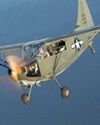WINGS OF THE FLEET
Flight Journal
|September - October 2025
Celebrating the U.S. Navy's 250-year legacy

THE CONTINENTAL CONGRESS established the United States Navy on October 13, 1775, authorizing two ships modified as privateers. It was an extremely modest beginning for what became the world's dominant sea power.
Some 136 years later, in 1911 the United States Navy entered the air age, borne upon wood and fabric wings and the spiritual lift of hope and optimism. That March, Congress appropriated the grandiose amount of $25,000 (about $835,000 today) for development of naval aviation. At the time the Navy had 51,000 men with 202 ships.
Dawn of naval aviation
Curtiss pilot Eugene Ely already had proven shipboard takeoffs and landings in 1910-1911, but the first aeroplane purchased under the daring initiative set back Uncle Sam some $5,500. Thus, the Curtiss A-1 series became the first of tens of thousands of aircraft acquired by the naval services: Navy, Marine Corps, and Coast Guard, over the next century. In the dawn of naval aviation, one name loomed large: Curtiss. So large, in fact, that it nearly dwarfed the other contestants combined, including the Wright company. Navy air’s first operation was supporting the landings at Vera Cruz, Mexico, in 1914. It was a minor event with two floatplanes operating from a tender, flown by Lieutenant Patrick Bellinger (Naval Aviator number 8) and three junior pilots, all eventually moving ashore.
The next year the Coast Guard formed an aviation branch, usually serving under the Treasury Department in peacetime. During the Prohibition era, 1920-1933, "Coasties" busily pursued liquor smugglers while aloft or afloat.
 First World War
First World WarThis story is from the September - October 2025 edition of Flight Journal.
Subscribe to Magzter GOLD to access thousands of curated premium stories, and 10,000+ magazines and newspapers.
Already a subscriber? Sign In
MORE STORIES FROM Flight Journal

Flight Journal
ELLIPTICAL ELEGANCE
Flying and evaluating the Seafire Mark III
4 mins
November - December 2025

Flight Journal
IRON DOG
Fighting the Pacific and the P-39 at the same time
14 mins
November - December 2025

Flight Journal
Fighter Pilots: A Warrior Clan
TAKE A HARD LOOK at the two young men in these photos. Do they look as if they were bent on killing one another? On the left we have a young, unknown enlisted Japanese pilot standing in front of a Nakajima Ki-27 \"Nate,\" one of Japan's earliest monoplanes that led to the much vaunted Zero.
3 mins
November - December 2025

Flight Journal
KEN WALSH THE FIRST CORSAIR ACE
Medal of Honor pilot's combat adventures
12 mins
November - December 2025

Flight Journal
Big Chief's Little Chief
Thunderbolt action with the Wolf Pack
11 mins
November - December 2025

Flight Journal
ENEMY PILOTS SPEAK Voices from the other side
All too often American students of air warfare forget that enemy aircraftwhether Messerschmitts or MiGs-were flown by human beings with the same motivations and traits as Allied airmen. More often than not, the only difference between friend and foe was the paint on the airplane and where they landed. Therefore, we've assembled a variety of accounts from WW II Axis fighter pilots, men who were more than simply targets.
11 mins
November - December 2025

Flight Journal
FLYING THE FW 190
A legend gets checked out in the Butcher Bird
15 mins
November - December 2025

Flight Journal
DOUBLE-THEATER ACE
The fearless missions of legendary fighter pilot Col. John D. Landers
12 mins
November - December 2025

Flight Journal
WARBUG IN THE PACIFIC
Surviving combat in a Stinson OY-1/L-5
10 mins
September - October 2025

Flight Journal
WINGS OF THE FLEET
Celebrating the U.S. Navy's 250-year legacy
9 mins
September - October 2025
Listen
Translate
Change font size

